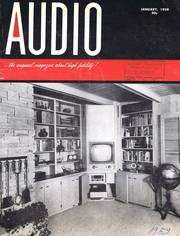Erläuterungen zu diesen US-AUDIO Seiten der 1950er Jahre
Die hier stehenden amerikanischen Artikel aus 1959 (aus der US-AUDIO) sind teilweise sehr gewöhnungsbedürftig, weil sie erstens aus einer längst vergangenen Zeit stammen und zweitens, weil dort in den USA ganz "anders" gedacht wurde als bei uns in Old Germany oder in Europa.
Vergleichbar mit unseren deutschen Hifi-Magazinen etwa ab 1962 ist jedoch, daß auch dieses Audio-Magazin ihre Anzeigen- Kunden und -Leser am Markt oder von anderen Magazinen (be- oder ab- ?) werben mußte. - Weiterhin sind die riesigen Dimensionen des amerikanischen Kontinents mit unseren hier in Europa nicht vergleichbar. - Ein Redaktions-"Trip" von New York nach Los Angeles oder Chicago oder gar in die Wüste nach Las-Vegas zu einer der CES- Audio- "Shows" war - auch mit dem Flugzeug - immer noch eine halbe Weltreise. Und jede Ausstellung oder "Messe" wurde als "Show" deklariert. Und natürlich, in USA musste alles "Show" sein, um beim Publikum einige Aufmerksamkeit zu erzeugen.
.
ABOUT MUSIC - "Lofty ORGAN Music in a Paris Church"
von HAROLD LAWRENCE
To the crew about to undertake a recording of the St. Sulpice organ, the most formidable impression made by this sprawling 18th centurv church is that of stairs.
Überall Treppen und Stufen - beeindruckend
Stairs in front of the center portals, spiral stairs winding up toward the organ loft, perilously narrow wooden stairs going to the platform above the mightly instrument, and more stairs to the uppermost ramp of the interior of the church.
The longest continuous stairway is the spiral one; taken at too fast a clip, this corkscrew-like ascent can set your head spinning by the time you reach the landing, and, if the steep climb does not make you dizzy, the view from the balcony down the full length of the church (some 400 feet) will do the job.
From here, powerful Delacroix frescoes look down upon noble columns bathed in a topaz-colored light (the temporary yellow stained-glass windows are replacements for wartime casualties).
The beauty of the proportions of the interior conveys a sense of repose and balance that is in marked contrast to the "exuberant decorative art of the lateral chapels, with their globe "clouds," cherubs, and concealed lighting. There is even a pair of gigantic Venetian shells in the aisles which are used as holy water vessels.
Jetzt mußte nur noch "Weg- optimiert" gedacht werden
All these stairs are located in the south tower of the church, the focal point of the preparatory work involved in the recording. In the manner of an army about to storm the heights of a medieval fortress, the first order of the day was to explore the tower from ground to turret in order to discover the most convenient and shortest route for the audio cables.
This, of course, was dictated by the placement of the microphones and the disposition of the playback room. Our guide for the investigation, M. Minard, the sacristan, brought with him a large batch of keys with which to open the numerous doors, gates and partitions as we proceeded moledike through the dimly-lit passageways.
Alle Lichtschalter hatten eine Zeituhr von etwa 1 Minute
Illumination was provided by means of a series of buttons found at regular intervals along the way. By pressing one of these, electric bulbs light up throughout the tower.
An automatic timing device turns off all the lights every minute or so, however, and you are then thrown into a dungeon-black darkness. A stranger in the tower, not knowing where the next light button was located, would have to grope forward cautiously, and search along the walls with his hands for the button. At moments like these, it was reassuring to have Minard with us; he would tell us to "freeze' while he clattered on confidently to the next button.
Die Orgel-Empore nach hunderten von Stufen
Scores of steps later we found ourselves in a corridor leading to the organ loft. We passed a row of belloAV-pedals, a carry-over from pre-automation days when the organ drew its breath from foot-operated bellows.
To the right, a legend engraved in the Avail listed the registration-stop pedigree of this mighty instrument, the largest on the Continent. At the end of the corridor is the organist's study, now occupied by Marcel Dupre who holds the coveted position of organist of St. Sulpice.
Der Vorgänger des Organisten spielte hier 64 Jahre
Dupre's predecessor, Charles-Marie Widor, held the post for no less than 64 years and, quite naturally, the little room is a tribute to his memory: there is an oil portrait of the late master as well as other memorabilia including his desk, furniture, and manuscripts.
In its simplicity and lonely setting it has a strangely moving effect on the observer.
Es ging aber noch höher hinauf - mit den Mikrofonen
Above the organ loft, through another locked door, we reached as far as stairs could bring us, namely, to the upper ramp of the interior. After looking over the array of pewter-toned pipes from, our vantage point, we calculated what the most practical microphone position would be; then we examined the walls of the church to locate a good rope-tying spot. (The railing along the ramp is precariously shaky.)
Much to our delight, the 18th-century architects had thoughtfully included a pair of built-in iron rings in the walls on both sides of the organ. We therefore strung our rope and pulleys through the rings.
Die Suche nach dem Regie und Abhörraum
Now that we had decided on an over-all microphone setup, the next plan of action was to locate the monitor room. This proved to be a more difficult undertaking. In terms of access to the console, there was, of course, the organist's study behind the organ loft; but this was rejected because of the size: it was large enough to accommodate the three speakers, all right, but no personnel.
The sacristan then suggested the ground floor chapel of the south tower which is in use only once a week. But that would have made it necessary for M. Dupre to climb the equivalent of seven stories in order to go from console to monitor room each time he wanted to hear a playback.
At this point, Minard recalled that there was a chapel (now abandoned) not far from the organ loft, on a slightly higher level. Up we went again. Opening a door behind the organ pipes, we ascended a narrow wooden staircase, pushed open a trap door, climbed a few stairs, and there we were.
Nur die Madonna verblieb in der Kapelle
Nothing remained of the chapel except a statue of the Madonna. The rest of the long room contained chunks of crumbling masonry, an oil canvas lying beneath a pile of broken straw chairs, several empty beer bottles, and some 1937 newspapers. Apparently the chapel had been used as a recreation room for construction workers during a period of church repairs.
.
Er war 50 jahre nicht mehr hier gewesen
We learned later that students' mass was celebrated here many years ago. When we told Dupre that we were going to utilize the old chapel as our playback room, he told us that he attended Sunday mass there as a boy. We invited him to look in and see wether he thought it would be suitable for him, and he directed us toward another door - the wrong door. He had forgotten the way over the years. Entering the chapel with us, he paused and looked at the ruined interior with tears wrelling up in his eyes: "Tiens," he said, "Just think, it's been 50 years since I last set foot in this place!"
Die Ausstattung der Kapelle
It was decided to use one end of the chapel as the playback area since it was more or less separated from the main part of the room. The lack of furniture and illumination was dealt with in a crude but effective manner: two battered chairs placed at a wide interval supported a long wooden plank, nail-studded and bristling with splinters; this constituted the work-table for the A.& B. department. For light, a dormant electrical outlet was discovered and put into service by an enterprising engineer.
The chapel, incidentally, became the assembly point for the monitor, microphone and intercom cables which had been hauled up the facade of the church from the recording truck below.
Wir wollten ja Magentbandaufnahmen machen
The object of all this activity was to capture on magnetic tape the sound of a renowned instrument performed by an artist who is thoroughly familiar with all its resources and capabilities.
Of the latter, the St. Sulpice organ is richly endowed. Built by Cavaille-Col during the last century, it is a product of the golden age of French organ building. As in the churches of Sacre-Coeur and Ste. Clothilde, Cavaille-Col achieved here a remarkable degree of purity of timbre.
While his St. Sulpice organ is admirably suited to the fullblown Romantic works of Widor, it nevertheless does justice to Bach and Couperin because the contrapuntal voices are projected without blurring or rumbling.
The first test recordings were made before midnight early last June (1959). The church was empty and the old district of St. Sulpice was as quiet as a provincial village at night except for the distant bustle of nearby Boulevards Raspail and St. Germain. Suddenly, the sound of this glorious instrument rolled into the star-filled Parisian night and echoed through the Place St. Sulpice and the streets leading into the square. Transfixed by the music, a lone bicyclist stopped to listen. It seemed as if the whole quartier joined with him.



